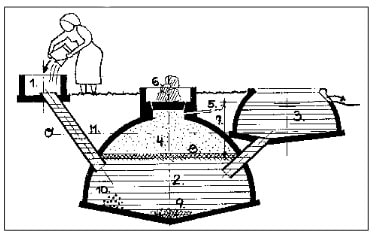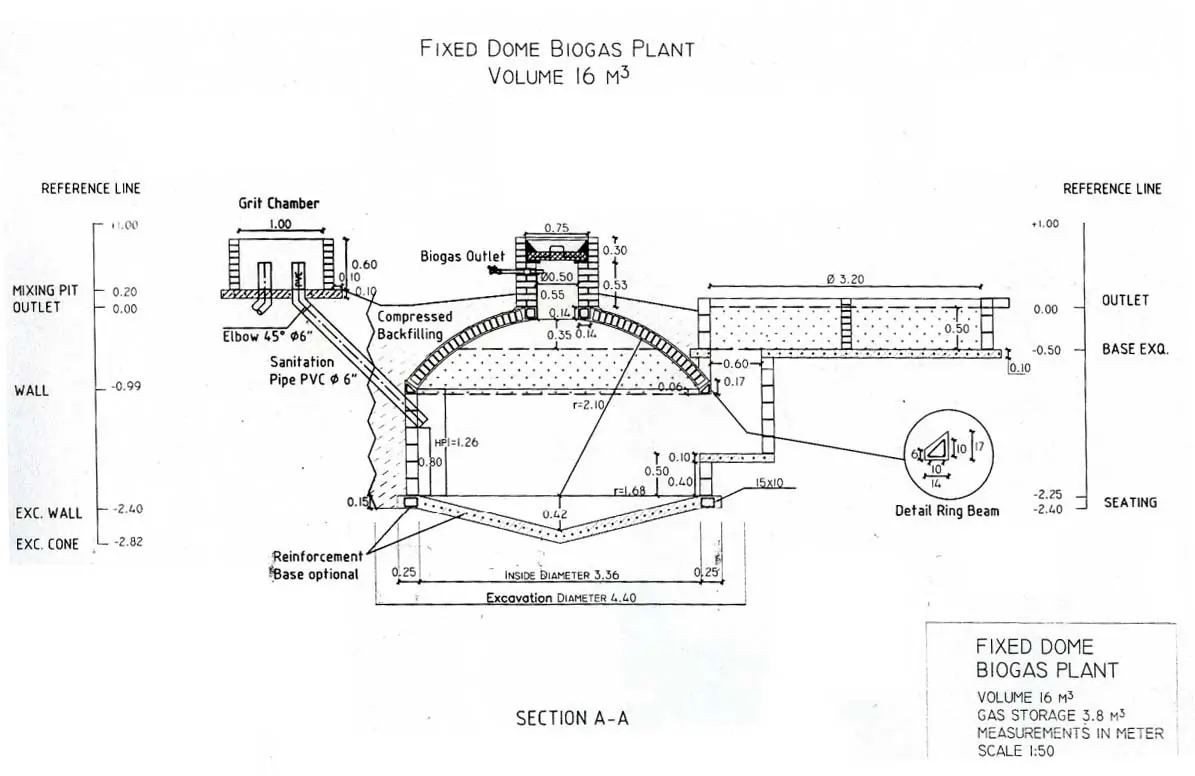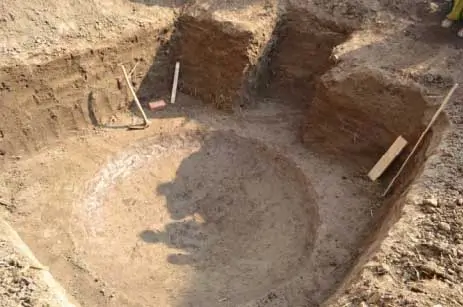Fixed Dome Biogas
The Chinese developed and built the fixed dome biogas system in the 1930s. The unit consists of an underground brick masonry compartment (fermentation chamber) with a dome for gas storage.

Fig 1. Fixed dome biogas plant. The numbers in the figure correspond to 1. Mixing tank with inlet pipe 2. Digester 3. Compensating and removal tank 4. Gasholder 5. Gaspipe 6. Entry hatch, with gastight seal and weighted 7. The difference in level = gas pressure in cm WC 8. Supernatant scum; broken up by varying level 9. Accumulation of thick sludge 10. Collection of grit and stones 11. Zero line: filling height without gas pressure.
A fixed-dome biogas plant consists of an enclosed digester with a fixed, non-movable gas space. The gas is stored in the upper part of the digester. When gas production commences, the slurry is displaced into the compensating tank. Gas pressure increases with the volume of gas stored. Therefore the volume of the digester should not exceed 20 m³. The gas pressure is low if there is little gas in the holder. A gas pressure regulator or a floating gasholder is needed if the gas is required at constant pressure (e.g., for engines). Engines require a great deal of gas, and hence large gasholders. The gas pressure then becomes too high if there is no floating gasholder.
Advantages:
Fixed dome biogas units have low construction costs, no moving parts, and no rusting steel parts. Hence long life (20 years or more), underground construction, affording protection from winter cold and saving space creates employment locally.
Disadvantages:
Plants often do not gaslight (porosity and crack; gas pressure fluctuates substantially and is usually very high, low digester temperatures.
These plants can only be recommended where experienced biogas technicians can supervise construction.
Deenbandhu – Fixed Dome Biogas
The Action for Food Production (AFPRO, based in New Delhi, India, took the original design of a fixed dome biogas plant and modified it in 1984 to considerably reduce construction costs. Consequently, the cheaper model was about 45% more affordable than other floating drum plants of similar size. The popularity of the Deenbandhu model saw its construction reach over three million.
Unique Design
The unique design of the Deenbandhu involves a spherical-shaped structure with a gas holder at the top and a concave bottom entirely built from brick masonry. Its popularity primarily comes from its affordability and simplicity of construction and maintenance. Additionally, AFPRO realised that using brick masonry instead of concrete or steel pipes drastically reduced construction costs without sacrificing stability or effectiveness.
Key Features
A key feature of the Deenbandhu is customisation for different locations by adjusting parameters such as size according to local energy needs, making it even easier for people in rural areas with limited resources to create a reliable energy source for their communities. Furthermore, since the technology is quite simple and easy to use, many farmers can repair their biogas systems independently without expensive external help.
In addition to providing an affordable form of renewable energy, the Deenbandhu also offers several environmental benefits, such as reducing air pollution due to burning wood or manure for fuel and reducing greenhouse gas emissions by converting animal waste into combustible methane gas instead of simply releasing it into the atmosphere. This low-cost biogas system greatly benefits the remote regions in India, where traditional energy sources are scarce.
The image above shows the Indian design with the bottom curved portion excavated by manual labour to the exact size. The depth and radius of the bottom curved portion vary according to the size of the plant.



Leave a Reply
You must be logged in to post a comment.